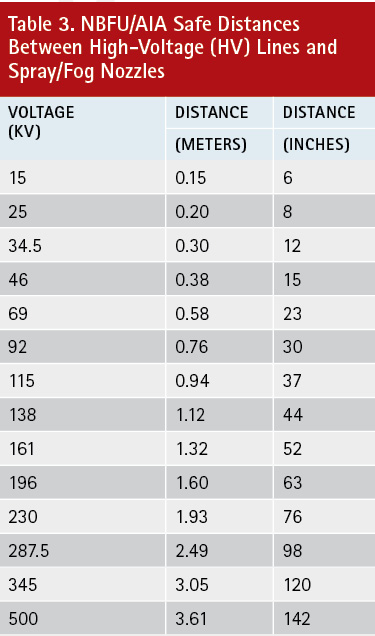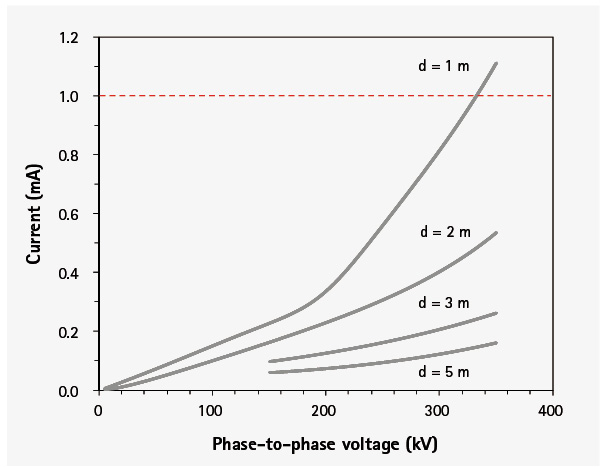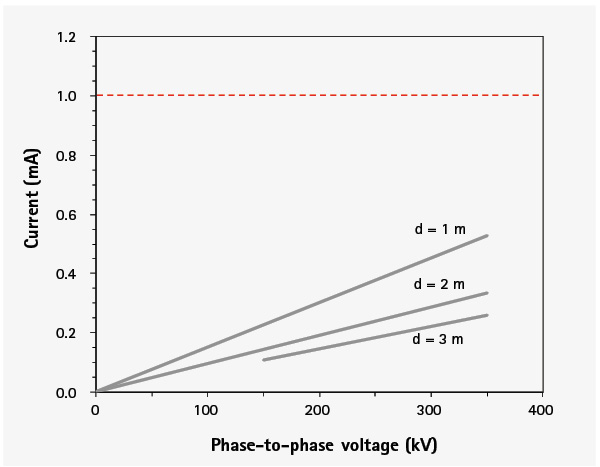
By VYTO BABRAUSKAS
Shock, injury, or death (electrocution) from the passage of electric current through a human body has been studied for more than a century. The level of response or injury depends on the magnitude of the current and also on the frequency, whether it is direct current (DC), power line alternating current (AC), or AC voltages of higher frequency. Some typical values are shown in Table 1.1 Children are generally more sensitive than adults; thus, guidelines often assume that a child is the person to be protected. With firefighting, however, this assumption is not reasonable. Furthermore, protection against a startle reaction is the most severe level of protection. A startle reaction is described as one in which a person jumps because of a small shock that does not injure the person. No direct electrical injury occurs because of startling; there is some hazard caused by jumping, but it is remote.
The “inability to let go” of an energized conductor that has been accidentally grabbed can cause pain and injury if the current increases to an injurious level. This is also called “muscle tetanization.” Thus, many safety requirements are based on a safety-factor-reduced value of the let-go current, even though this is quite a conservative stance. Matters are further complicated. Since individuals show variation in their responses and standards, bodies typically pick a very conservative level (often the 0.5 percentile) instead of the 50-percentile value. Physiological effects of electric current, furthermore, depend strongly on frequency. The most dangerous frequencies are the 50- or 60-Herz (Hz) power line frequencies. The human body becomes less sensitive to electric current at high frequencies.2 Dalziel3 has published a useful summary of safety guidance on electric shock.

Water Streams and Power Lines
Generally, a minimal-to-nil hazard shock hazard is associated with most extinguishing agents apart from water. Water, however, can have a significant electrical conductivity and, consequently, a potential for electric shock. The actual hazard, however, is largely imagined rather than real. Clark4 summarized the issues on this topic succinctly: “While I have not been able to discover a single case of a firefighter being electrocuted by current conducted through a hose stream, I do know of four deaths brought on by ladders in contact with charged wires …. [T]here have been cases where firefighters were held back by an unwarranted fear of electricity.” The latter comment is most important. Education concerning the actual hazards of electric shock is evidently very limited in the fire service, and it is, unfortunately, too common to find that the incident commander (IC) would let a building burn to the ground based on a fear of electric shock in circumstances in which no realistic opportunity for shock is present.
Before considering details of experimental studies, it is important to consider the nature of the water used. Water’s resistivity depends on the amount of dissolved salts it contains, which can vary. Seawater has a resistivity of roughly 0.2 ohm-meters (Ω-m), while highly purified water can have 104 Ω-m. Apart from ships and marine installations, where seawater is likely to be used, neither of these extremes is germane. In extreme cases, public water supplies5 may show resistivities in the range of 5 to 50 Ω-m. However, in the United States, public water supplies generally show resistivities of between 12.5 and 50 Ω-m; converted into conductivity units, this is a range of 0.08 to 0.02 Siemens/meters (S/m).
Solid Streams
Over the years, a large number of studies have examined the potential for shock from operating water streams near high-voltage installations. Solid streams and fog (spray) streams are hugely different in their ability to conduct electricity; thus, we must consider the type of stream used to ensure relevant research results. Even a solid stream, however, will break up into droplets if the projection distance is great enough. Once water is in the form of discontinuous droplets, electrical conduction proceeds by arcing from droplet to droplet. Much work was done during the 1930s to 1960s, and O’Dogherty published a comprehensive review of the literature up to 1964. (5)
For solid streams, the recommended safety distances range nearly over a factor of 10, partly because of differing assumptions as the maximum permissible current but also because of the variations in the conductivity of water and the type of stream produced. Spray nozzles did not achieve widespread usage until late in the 1950s, yet today it would generally be considered inappropriate to direct solid streams at energized high-voltage equipment. Thus, early research that studied only solid streams is of limited value.
The safety distances needed depend primarily on two factors: (a) the conductivity of the water and (b) the acceptable leakage current criterion. For a leakage criterion, O’Dogherty chose 1 milliampere (mA), but he noted that some authors recommend use of 3 mA as the criterion. Note, for comparison, that ground fault circuit interrupter (GFCI) devices are typically set for 5 mA in North America. This 5 mA value is conservatively chosen to be below levels that could cause injury and, even further, below the “let go” value of current. (3)
Spray Nozzles
In the United States, for many years practical guidance regarding the safety distance for spray nozzles was provided by Special Interest Bulletin No. 91, initially issued by the National Board of Fire Underwriters (NBFU) in 1939.6 The bulletin was revised several times, and spray nozzle values were later added. The NBFU later became a division of the American Insurance Association (AIA), which reissued the bulletin.7
Table 2 shows the NBFU/AIA recommendations for solid-stream nozzles; Table 3, those for spray nozzles. Note that the data for straight-stream nozzles included only distribution-level voltages, not transmission-level voltages. The AIA has deemed its bulletins to be obsolete, however, because the organization decided to eliminate all of its engineering advisory guidance publications. The solid-stream data in the NBFU Bulletin were originally published by Walker8, although he was not credited; the source of the data for the spray nozzles was an old edition of National Fire Protection Association (NFPA) 15, Standard for Water Spray Fixed Systems for Fire Protection.


For spray nozzles, in his 1965 review, O’Dogherty (5) recommended the results of Fitzgerald9 and some unpublished values from the Chicago (IL) Fire Department10 (CFD) since they are quite similar throughout the range of voltages. Both of them are shown in Figure 3, but first we must consider some more current data.
Most of the research on this topic, in fact, is very old; the only modern study has been that of Verlo11 conducted at the Norwegian SINTEF research institution in the early 1990s. He measured two water supplies: a brackish harbor water (0.32 S/m) and an urban water supply purer than that normally found in North America (0.0055 S/m). Thus, his results bracket the range of conductivities expected in North American water supplies. Verlo’s results are shown in Figure 1 and Figure 2 for brackish and for pure water, respectively.
Verlo published his original voltage measurements on a phase-to-ground basis. For convenience, they have been converted and reported here as system voltages, phase-to-phase (since they are more commonly cited for electric distribution networks).
Also shown on these figures is the conservative 1 mA criterion that has been used. For brackish water, it would require 330 kilovolts (kV) at a 1.0 m spacing for the 1 mA criterion to be reached. For pure water, an extrapolation suggests that 650 kV would be needed at a 1.0 m spacing for the 1 mA criterion to be reached. As noted above, the conductivity of North American public water supplies will be roughly halfway between these two extremes; thus, about 500 kV at a distance of 1.0 m (39 inches) would be expected to reach the 1 mA criterion value. But such a close distance is unreasonable for firefighters to consider simply because of the direct hazard from the power line itself; thus, it can be concluded that there can be no anticipated shock hazard from using spray nozzles even on extra-high voltage (EHV) power lines.
Safe Distances
A direct comparison of the results of various authors for spray nozzles is shown in Figure 3. It can be seen that there are major differences, and it is important to understand why. One consideration is, as O’Dogherty pointed out, “the safe distance must be greater the larger the conductor voltage, because of the increase in stream current arising from direct proportionality to the voltage.” (5) Thus, the Fitzgerald data are obviously not valid measurements. Furthermore, the data points must pass through the origin of the graph, since there is no hazard from zero voltage. Not mentioned in O’Dogherty’s review, but evident from Fitzgerald’s original article, the reason for the odd behavior is that what he reported in these series of numbers was not the results of measurements but some very conservative safety recommendations. All the points at lower voltages correspond to four feet, since for other reasons it was sensibly considered that firefighters should leave a four-foot distance between them and power lines, not because a hazardous current leakage was measured.
Figure 1. Spray Nozzle Leakage Current (Brackish Water)

As a function of voltage and distance for brackish water (0.32 S/m). To convert to phase-to-ground voltage, multiply by 0.577.
In his original paper, Fitzgerald reported a single data point as a measurement for a spray nozzle safety distance: three feet from a 115 kV line. But even here, neither the technique nor the criteria are clear. The CFD data, on the other hand, used an unknown criterion and further added an unspecified safety factor. This is not appropriate, since the 1 mA criterion by itself contains a 600-percent safety factor with regard to an exceptionally sensitive adult.
Figure 2. Spray Nozzle Leakage Current (Pure Water)

As a function of voltage and distance for pure water (0.0055 S/m). To convert to phase-to-ground voltage, multiply by 0.577.
Figure 3. Suggested Safe Distances for Spray Nozzles

To convert to phase-to-ground voltage, multiply by 0.577.
To compare to the single Verlo modern study, only the results for brackish water are plotted, since the data points for pure water are so much lower than 1 mA that extrapolation could not reasonably be made (very roughly, it may be assumed that the curve for pure water would be about a factor of four below the curve for brackish water, whereas the curve for typical North American drinking water might be a factor of two below). For the lower-voltage data points, Verlo’s experimental curves had to be extrapolated. As you can see, throughout most of the range, the slope of all curves is quite similar, but there are obviously very significant differences from the old data. Analysis of the data suggests that the reason for this is as follows: Verlo’s data are based on actual measurements, including the use of a very conservative criterion. The numbers from Fitzgerald, the CFD, and the NBFU are either estimates bereft of measurement or else originated from data overlaid with multiple safety factors, with the original data being unknown or unpublished.
Based on this understanding, Verlo’s data can be used as reliable values for brackish water supplies. Normal public water supplies will not be brackish; thus, distances about half of his values could be assumed to be safe. It is clear that for both distribution voltages (34.5 kV or lower) and transmission voltages (above 100 kV), any potential hazards would occur only if holding nozzles at totally unreasonably short distances from high-voltage lines or equipment.
Recommendations
With regard to building wiring, apart from heavy industry, voltages are generally 480 volts or less. In such cases, nozzles would have to be brought within a hand’s length of the energized equipment for there to be any shock hazard. Thus, it is not reasonable to preclude an interior fire attack on the basis that energized conductors might be present. On the other hand, there is a danger of electrocution when using an aerial apparatus carelessly in the vicinity of power lines. But this comes from the possibility of physical contact, not shock from current flow through a water stream. Here, the recommendation of Fitzgerald is appropriate: Stay at least four feet (1.22 m) away from all HV power lines, for general personnel safety reasons. For HV wiring, Verlo’s results are reliable when using spray nozzles. Fewer buildings will be lost to fire if ICs understand and remember these instructions.
Finally, this analysis does not imply that it is appropriate to deal with arcing in electrical wiring or equipment by directing hose streams against them. In such cases, energy is being delivered largely or entirely by electric current, not by combustion. Thus, the proper action is to get the equipment de-energized. Hose streams should be used only to extinguish structures or other combustibles that are burning (electric arcing is not something burning). If straight streams are needed and there is some electrical equipment nearby, then the NBFU recommendations will provide a high margin of safety.
References
1. Skuggevig, W. Personnel Protection Devices for Specific Applications (EPRI TR-114090), EPRI (1999).
2. Turner, HS, Human Responses to Electricity: A Literature Review (N7310065), NASA, Washington (1973).
3. Dalziel, CF, Electric Shock Hazard, IEEE Spectrum 41-50 (Feb. 1972).
4. Clark, WE, Firefighting Principles & Practices, (second ed.), Pennwell, Saddle Brook, NJ (1991).
5. O’Dogherty, MJ, The Shock Hazard Associated with the Extinction of Fires Involving Electrical Equipment (Fire Research Tech. Paper No. 13), HMSO, London (1965).
6. Fire Streams and High Tension Electric Lines (Special Interest Bull. No. 91), National Board of Fire Underwriters, New York (1939).
7. Fire Streams and Electrical Circuits (Special Interest Bull. No. 91), American Insurance Association, New York (1975).
8. Walker, HS. High Tension Wires and Hose Streams, NFPA Q. 24:2, 169-183 (Oct. 1930).
9. Fitzgerald, GWN. Fire Fighting near Live Electrical Apparatus, Ontario Hydro Research News, 11:2, 13-16 (1959).
10. Tryon, GH, ed. Fire Protection Handbook, 12th ed., NFPA, Boston (1962); 15-1 to 15-14.
11. Verlo, T, Water as an Extinguishing Agent against Fires in Cables and Electrical Installations, Session 2, Paper 3 in Conf. Proc.—Cables and Fire Protection, ERA Technology Ltd, London (16 Jan. 1992).
VYTO BABRAUSKAS, Ph.D., earned degrees in physics and structural engineering and a Ph.D. in fire safety. As a researcher at the National Institute of Standards and Technology, he developed devices to measure the heat release rate of products and developed a computer program for modeling the development of room fires. He founded a consulting firm in 1993 and provides fire safety science expertise to fire investigation and litigation.

